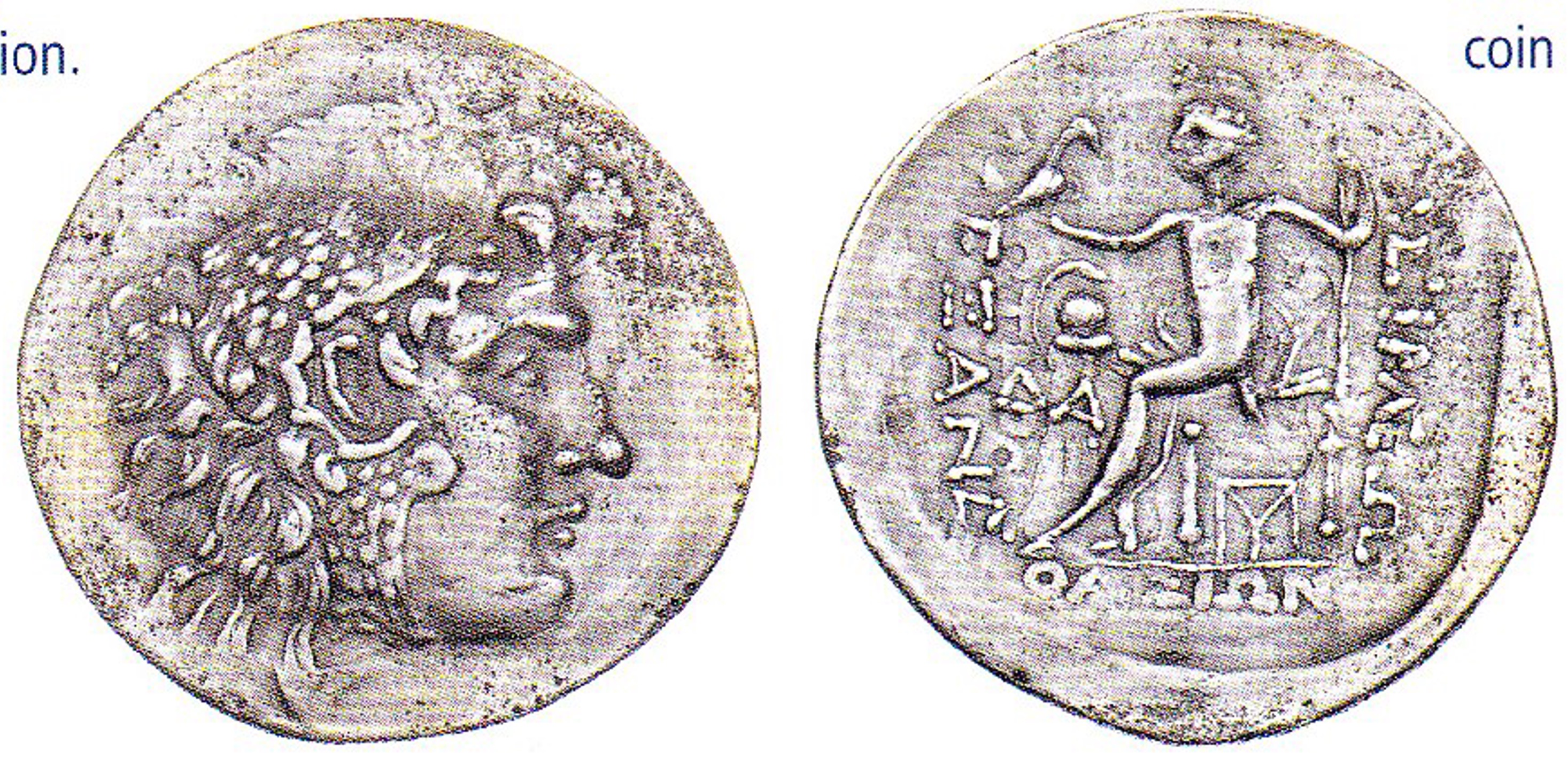90 BCE - 70 BCE | BAΣΙΛΕΩ AΛΕΞANΔΡ (sic)
Overstriking coin
SO 826 - Mesembria (Alexander the Great) over Thasos.jpg
Overstruck variety
Thasos tetradrachm.jpg
[1]
SO 826 - Mesembria overstruck variety.jpg
Description
| ObverseInscription or printing placed on the obverse.:
|
Head of Herakles right, wearing lion skin headdress.
|
ReverseInscription or printing placed on the reverse.:
|
BAΣΙΛΕΩ AΛΕΞANΔΡ (sic) Zeus enthroned left, holding eagle and scepter. Under the throne, monogram. In field, Corinthian crested helmet and ΔΑ.
|
Mint and issuing power
| MintIdentifies the place of manufacture or issue of a numismatic object.:
|
Mesembria
|
Ancient regionAncient region.
|
Thrace
|
Modern countryModern country: Bulgaria
|
AuthorityIdentifies the issuing power. The authority can be "pretended" when the name or the portrait of X is on the coin but he/she was not the issuing power. It can also be "uncertain" when there is no mention of X on the coin but he/she was the issuing power according to the historical sources:
|
Alexander III the Great (Argead king, 336-323 BC)
|
Chronology
| FromIdentifies the initial date in a range assigned in a numismatic context. 90 BCE toIdentifies the final date in a range assigned in a numismatic context.. 70 BCE
|
Hellenistic 323-30 BC  periodTime period of the numismatic object. periodTime period of the numismatic object.
|
Physical description
MetalThe physical material (usually metal) from which an object is made.: Silver 
|
WeightWeight of the numismatic object (in grams). in grams: 16.7916.79 g <br />16,790 mg <br />
|
DenominationTerm indicating the value of a numismatic object. Examples: tetradrachm, chalkous, denarius.: tetradrachm 
|
AxisDescribes the directional relationship between the obverse and reverse of a numismatic object.: 1212 mm <br />1.2 cm <br />
|
|
|
StandardStandard.: Attic
|
References
| Coin referenceReference of the Coin:
|
MacDonald 2009, p. 129, n° 98, Callataÿ 2021a, p. 277, n° 24
|
Coin series referenceReference to coin series study:
|
Karayotov 19941Karayotov 1994, p. 93, n° 286-288 (O47-R128 monogram combination 43), Price 19912Price 1991, n° 1047, MacDonald 20093MacDonald 2009, p. 129, n° 98, Callataÿ 2021a4Callataÿ 2021a, p. 277, n° 24
|
Description
| ObverseInscription or printing placed on the obverse.:
|
Head of Dionysos right, wearing ivy wreath (visible: upper part of the head in the upper field and bust termination).
|
ReverseInscription or printing placed on the reverse.:
|
HPAKΛEOYΣ ΣΩΤΗΡΟΣ ΘΑΣΙΩΝ (Greek) Herakles standing, nude, holding lion skin and club.
|
Mint and issuing power
| MintIdentifies the place of manufacture or issue of a numismatic object. ᵖ:
|
Thasos
|
Ancient regionAncient region. ᵖ
|
Thrace
|
Modern countryModern country: Greece
|
AuthorityIdentifies the authority in whose name (explicitly or implicitly) a numismatic object was issued. ᵖ:
|
|
Chronology
| FromIdentifies the initial date in a range assigned in a numismatic context. 148 BCE toIdentifies the final date in a range assigned in a numismatic context.. 70 BCE
|
Hellenistic 323-30 BC  periodTime period of the numismatic object. periodTime period of the numismatic object.
|
Physical description
| DenominationTerm indicating the value of a numismatic object. Examples: tetradrachm, chalkous, denarius. ᵖ:
|
tetradrachm 
|
StandardStandard. ᵖ:
|
Attic
|
References
References
- ^ Karayotov, Ivan (1994), The coinage of Mesambria. vol. 1: silver and gold coins of Mesambria, Centre of Underwater Archaeology, Sozopol, 134 p. and 44 pl.
- ^ Price, Martin Jessop (1991), The Coinage in the Name of Alexander the Great and Philip Arrhidaeus: a British Museum Catalogue, 2 vol., Zürich-London, 637 p., 637 p., clix pl.
- ^ MacDonald, David (2009), Overstruck Greek coins: studies in Greek chronology and monetary theory, Whitman Publishing, Atlanta.
- ^ Callataÿ, François de (2021), “On pattern and purpose of overstrikes of late Hellenistic tetradrachms in Thrace Macedonia”, in Ulrike Peter and Bernhard Weisser (eds.), Thrace. Local coinage and regional identity, Berlin Studies of the Ancient World 77, Berlin, Topoi, p. 263-289.
 Traces of the overstruck variety
Traces of the overstruck variety

